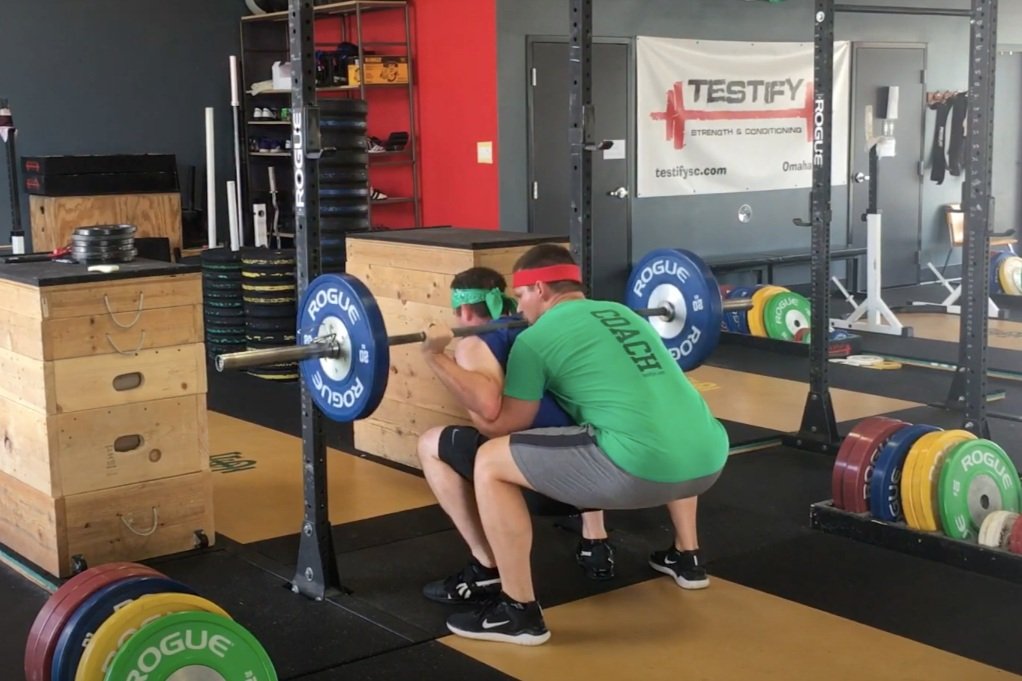The Pin Squat: What, How, and Why
/In last Friday’s article, we covered the tempo squat. Today, let’s briefly discuss the pin squat.
What is a pin squat?
A pin squat is a squat wherein you descend, set the bar on the pins (AKA safeties, crash bars, or spotter arms) at the bottom of the squat, pause for a moment, and then squat the weight back up again.
How do you perform a pin squat?
You descend as you would in a normal squat - hips go back, knees go forward and out (staying in line with your toes), and your chest points down. The pins should be set so that - at the bottom of your squat (when the bar is on the pins) - your hip crease is just below the top of your patella.
In other words, the pins need to be set so that you can hit depth, and checking this on video is always a good idea if you’re coaching yourself.
Once both sides of the barbell are in contact with the pins, pause a legitimate one to two seconds (“one-thousand-one, one-thousand-two”), and stay tight during this pause. You should still be supporting most of the weight of the bar.
After the pause, drive the hips up out of the hole as you would in a normal squat and continue your ascent. Don’t be surprised at how slow the ascent is - pin squats are never fast.
Why might you do pin squats or where might you see them in your programming?
Let’s say your coach has programmed you within a Heavy-Light-Medium structure or something similar - in this case, you might see a pin squat show up as a medium day squat or even a light day squat (the loading and volume need to be carefully managed - especially if it’s a light day squat).
Due to the pause on the pins, the pin squat eliminates the stretch reflex out of the bottom, so it’s a disadvantaged squat, and thus you’ll need to use a lighter weight than with your regular squat, so it fits the bill for a medium or light squat.
However, as with last week’s tempo squat (click here for the article or check out the video earlier in this article), remember that “lighter” does not necessarily mean easy.
The pin squat - again like last week’s tempo squat - can also be useful for a number of other reasons - one of which is that it can help a lifter focus on a specific aspect of his technique.
For example, if Peter tends to squat with his knees too far forward and his back angle too vertical, a pin squat will encourage him to lean over more to get the bar down to the pins. On the other hand, if Mary struggles with hitting depth, a pin squat will force her to correct this - quite simply, if the bar doesn’t contact the pins, the rep doesn’t count (a box squat can be used for this as well). Finally, if Ben tends to relax and “get loose” as he descends, a pin squat will punish this type of behavior, and thus it will remind him to stay tight throughout the entire rep.
This wraps up our short discussion of the pin squat, and in an upcoming article, we’ll move on to the box squat.
As always, we hope this helps you get stronger and live better.
-Phil
PS: Whenever you want even more Testify in your life, here are some free resources:
Book a free intro and strategy session with us HERE.
Pick up a free copy of Testify’s Squat Guide: 12 Tips to Improve Your Squat Now HERE.
Get our free weekly email - containing useful videos, articles, and training tips - HERE.
Follow Testify on Instagram HERE.
Subscribe to Testify’s YouTube channel HERE.
(Some links may be affiliate links. As an Amazon Associate, Testify earns from qualifying purchases.)

















